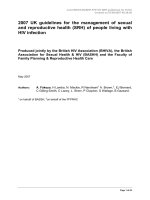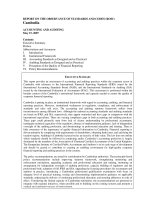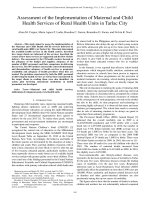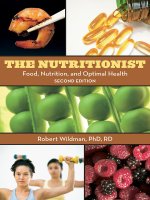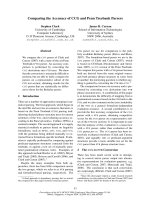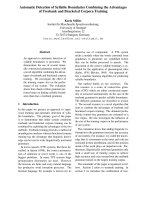The Encyclopedia Of Nutrition And Good Health - Q doc
Bạn đang xem bản rút gọn của tài liệu. Xem và tải ngay bản đầy đủ của tài liệu tại đây (356.39 KB, 2 trang )
Q
547
quercetin
A widely distributed plant pigment that
is classified as a
FLAVONOID. It is found in fruits like
APPLES, vegetables like ONIONS, and in TEA. A typical
Western diet supplies about 25 mg of quercetin
daily. Onions, apples, kale, sweet cherries, grapes,
red cabbage, and green beans are good sources.
Quercetin produces a broad range of effects in the
body. It can function as an
ANTIOXIDANT to quench
highly reactive chemicals called
FREE RADICALS.
Together with
VITAMIN C, quercetin helps strengthen
fragile capillaries and connective tissue. It can inhibit
tumor formation and modulate enzymes in the liver
that degrade drugs, pollutants, and cancer-causing
agents. Quercetin can reduce inflammation by
blocking the formation and the release of inflamma-
tory agents, and it possesses antimicrobial activity as
well. (See also
PHYTOCHEMICALS.)
quince (Cydonia cydonia) A yellow, pear-shaped
FRUIT harvested from the cydonia tree, native to
Iran and the Caucasus. The flesh is hard and
extremely tart, preventing it from being eaten raw.
Quince contains high levels of pectin, a gel-form-
ing fiber. It is used in marmalades, jellies, jams,
fruit preserves, and syrup as a thickening agent.
One quince (151 g) provides 53 calories; protein,
0.37 g; carbohydrate, 14 g; fiber, 1.6 g; potassium,
181 mg; vitamin C, 14 mg; thiamin, 0.018 mg;
riboflavin, 0.028 mg; niacin, 0.18 mg. (See also
CIT-
RUS FRUIT.)
quinoa (chenopodium) A grain-like product
unrelated to true grains. A cousin to spinach and
swiss chard, quinoa produces edible greens in addi-
tion to its seeds, which form large clusters at the
end of the stalk. Domesticated and grown in South
America for 5,000 years, quinoa was cultivated by
the Incas. This hardy plant grows well at high ele-
vations that experience little rainfall.
Quinoa is imported from South America.
Domestic supplies come from the Rocky Mountain
region (Colorado). The seeds are protected by a
resin-like layer (saponin), which must be removed
by treatment with alkali to be edible. The cleansed
grain resembles millet. Quinoa has a high protein
content. Quinoa protein is well balanced in essen-
tial
AMINO ACIDS and has substantial amounts of
lysine, unlike cereal grains. Quinoa also contains
more iron than other grains and contains substan-
tial amounts of other trace minerals and calcium,
as well as B complex vitamins. The cooking time
for quinoa is shorter than for rice or millet. Its del-
icate taste combines well with other grains in pilaf
or baked grain casseroles.
The nutrient content of 3.5 oz. (100 g) of dry
grain is 374 calories; protein, 13 g; carbohydrate,
69 g; fat, 6 g; potassium, 740 mg; iron, 9 mg; thi-
amin, 0.2 mg; riboflavin, 0.4 mg; niacin, 3.0 mg.
quinone A family of lipids that readily undergo
oxidation-reduction reactions. Two important
quinone derivatives occur in the body:
VITAMIN K
and COENZYME Q. Vitamin K serves as a cofactor in
the synthesis of several proteins required for
BLOOD
CLOTTING
, while coenzyme Q functions as an elec-
tron carrier in
MITOCHONDRIA, the cell’s power-
houses. Coenzyme Q participates in the transfer of
electrons to convert
OXYGEN to water. At the same
time
ENERGY is trapped as ATP, a chemical form used
by the cell. (See also
ELECTRON TRANSPORT CHAIN;
OXIDATIVE PHOSPHORYLATION.)
quorn A meat substitute made from the fungus
Fusarium venenatum. To make quorn the fungus is
grown in large fermentation vats, producing a
microprotein. The substance is then spun at high
velocity in a centrifuge to remove water. The
remaining material (quorn) is then mixed with
other ingredients, including flavor enhancers and
egg whites, to create a substance that looks and
tastes like meat. Pound for pound, quorn contains
fewer calories and less saturated fat and cholesterol
than do chicken or beef.
Quorn has been sold in Great Britain since 1985
and has become the most popular meat substitute
in Europe. In 2001 the U.S.
FDA allowed quorn to
be marketed to U.S. consumers as a “generally rec-
ognized as safe” (GRAS) food. Since then some
consumer groups have raised concerns about the
labeling and safety of quorn. Critics say that state-
ments on quorn products that claim it is derived
from the “mushroom family” are false and mis-
leading. Some consumers have reported allergic
and other adverse reactions to eating quorn. One
serving of quorn “chicken” nuggets (100 g) pro-
vides 212 calories; protein, 9.4 g; fat, 9.4 g; choles-
terol, 0 g.
Miller, S. A., and J. T. Dwyer. “Evaluating the Safety and
Nutritional Value of Mycoprotein,” Food Technology 55,
no. 7 (2001): 42–47.
548 quorn
